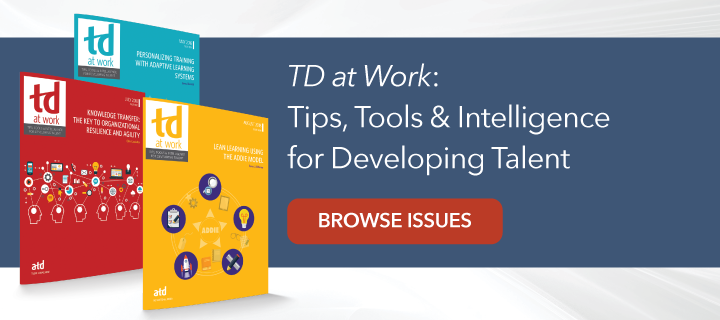“COVID-19 Adding to the ‘High Level of Psychological Distress’ for Healthcare Staff, Medics Warn.”
“Hospitals Conduct Counseling Sessions to Help Doctors and Healthcare Workers Beat Stress.”
“Healthcare Workers Suffer From PTSD and Burnout During COVID-19.”
These are just a few recent headlines that point to the effects of the working conditions of our frontline medical personnel. What can talent development professionals do to help? “A Best Practices Guide to Healthcare Development” is a collection of TD at Work issues that provides tools and guidance for TD practitioners so they can help healthcare workers. The collection focuses on the areas of interprofessional education, emotional intelligence, coaching, and employee engagement.
Interprofessional Education
“Quality relationships in the workplace lead to improved employee morale, greater collaboration, higher employee retention rates, and increased productivity. When relationships are poor and there is a lack of trust in the working environment, it affects employees, such as through burnout,” write Christina Barss and Angela J. Patchell.Interprofessional education (IPE) can help foster trust and raze silos. This is done through the establishment of a common language and mutual respect for what each person in the healthcare system—administrator, head physician, nurse, therapist, and so on—brings to the table, understanding that no one practitioner has all the necessary knowledge, skills, and abilities to care for the patient.
Facilitating IPE can be done through role plays, simulations, and clinical observation, to name a few. For example, a physician could develop a better appreciation for what nurses do when caring for a patient on regular rounds. Better relationships among healthcare workers also lead to improved patient outcomes and experiences, which is a win for everyone from the patient to the facility.
Emotional Intelligence
The emotional intelligence framework outlined by Joann Farrell Quinn and Sarah E. Hoffe consists of self-awareness, self-management, social awareness, and relationship management.What could this look like in a healthcare setting? One example is an interaction between a doctor and a patient’s family members. It means the doctor understands that the family members are under stress and are worried about their loved one. The doctor expresses empathy and considers the family’s feelings when explaining the treatment plan, patiently repeating anything as required.
A talent development professional can help healthcare staff understand stumbling blocks to communication, such as language barriers and personality differences. Further, the TD professional can help staff understand where and why there is conflict within the organization (for example, between an administrator and a head physician), perhaps facilitating a role play scenario with staff.
Coaching in Healthcare
Self-care, work-life challenges, and burnout among healthcare employees were the primary blocks to engagement and performance, write D.J. Mitsch, Mark Greenawald, and Cindi Ackrill, referring to research conducted by ATD for their issue of TD at Work written before the pandemic began.TD professionals can help healthcare personnel understand and address some issues that are prevalent in the field: perfectionism, a sense of knowing it all, risk aversion, and burn out.
In their work, TD coaches provide a safe space for healthcare staff to explore tensions and reignite curiosity, encouraging individuals to look at a situation in a different light, acknowledge and delve into their feelings, and consider their own energy levels and work-life balance.
Employee Engagement
Jill Christensen writes that 56 percent of healthcare workers are disengaged. The study she cited was conducted well before the COVID-19 pandemic. Factors for those feelings included the constant change in the healthcare industry, such as changes in the US system brought about as a result of the Affordable Care Act, long hours, lack of trust between staff, and so forth. While employee engagement is always important to organizations, in healthcare employee engagement leads to improved clinical excellence, patient care, and patient experience.Christensen advises, “For your company to have an engaged workforce and succeed, you must have the right person in every chair.” That means hiring the right people with the right skills, yes; but it also means ensuring that the organization’s values translate to the culture. Do this by using the performance management system to measure whether employees are acting out organizational values in their day-to-day work. A second way to improve engagement is to make sure there’s an alignment between organizational goals and employee goals. Finally, there needs to be a culture of two-way communication.
Begin your employee engagement strategy by identifying a core team, gathering baseline data, creating a strategy, and introducing it to managers via a townhall.
“At the end of the day,” Christensen concludes, “healthcare is a profession that relies on caring and connection—for both your employees and your patients. The more you care for and connect with your people, the more they will care for and connect with the people you serve.”




